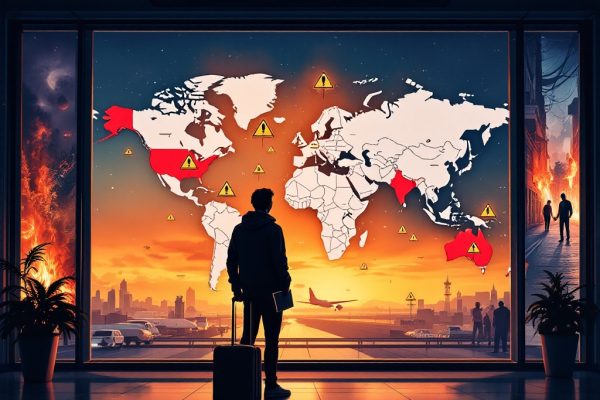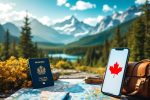Passports and Visas: All You Should Know
Planning international travel? Understanding passports and visas is crucial. This comprehensive guide covers everything from passport applications and renewals to various visa types and requirements. Learn about expedited passport services, the importance of biometric information, and what to do if your passport is lost. Explore different visa categories, including travel, work, student, and refugee visas, and understand the application process and supporting documents needed. Don’t let passport or visa issues derail your trip – equip yourself with the knowledge you need for smooth and hassle-free international travel. Read on to start planning your next adventure!
Important information

- A passport verifies your identity and citizenship, essential for international travel.
- Visas grant entry to a specific country for a defined purpose and duration. Your visa must be valid when you arrive.
- Various visa types exist (tourist, work, student, etc.) depending on your trip’s purpose.
- Visa policies and restrictions vary by country and can change, so always check the latest requirements with the destination country’s embassy or consulate.
- Overstaying a visa can lead to penalties, including potential deportation and difficulty obtaining future visas.
Understanding Passports and Visas
Your passport, an official government-issued document, verifies your identity and citizenship, proving crucial for international travel. Visas are added to your passport like permission slips, granting you entry to a specific country for a particular purpose and duration. While a visa allows you to travel to the border, the final entry decision rests with border officials. Therefore, your visa must be valid upon arrival. The type of visa required—tourist, work, or student—depends on the nature of your trip.
Passport
verifies your identity and citizenship, essential for international travel.
Visa
grants entry to a specific country for a particular purpose and duration; must be valid upon arrival.
Types: tourist, work, student, etc., depending on the nature of your trip.
Passports: Application and Renewal
Applying for a passport, whether for the first time or a renewal, is generally a simple procedure.
First-Time Application
- Completed application form,
- Proof of citizenship (like a birth certificate),
- Government-issued photo ID,
- Passport photos,
- Application fee.
Renewal Application
- Different application form (specific for renewals),
- Most recent passport,
- Recent passport photo,
- Renewal fee.
Expedited processing may be available for those needing their passport quickly.
How to Apply for a Passport
Getting a U.S. passport is easier than you think. Follow these simple steps:
Complete Form DS-11. This is the application form for a U.S. passport.
Gather your supporting documents. You will need proof of U.S. citizenship (such as a birth certificate or previous passport), a government-issued photo ID (like a driver’s license), and a recent passport photo that meets U.S. passport requirements.
Pay the required fees. The fees vary depending on the type of passport and service you require.
Submit your application. You can submit your application online or in person at an acceptance facility.
Processing times may vary, so apply early.
Passport Renewal Process
Passport renewal is a straightforward process. First, complete the application form. Then, gather your current passport and a recent photo. Next, pay the applicable fee. For urgent travel, expedited service is available, but eligibility requirements apply. Finally, review the guidelines, as your situation may require additional steps.
Expedited Passport Services
Need your passport quickly? Expedited service significantly reduces the standard waiting time, making it ideal for urgent travel needs like medical emergencies or last-minute business trips. This faster option comes with an additional fee, but it ensures you get your passport when you need it most.
Passport Fees and Processing Times
Passport fees at a glance: A new adult passport book costs $165, while renewals are $130. A passport card costs $30 for first-time applicants and $15 for renewals. Standard processing takes 10-12 weeks. Expedited service (2-3 weeks) costs an extra $60. For urgent travel (7-9 business days), you’ll need proof of travel and an additional fee.
What to Do If You Lose Your Passport
Losing your passport can be a stressful experience, but taking swift action can simplify the replacement process. Report the loss to the local police immediately and obtain a police report, this document is crucial for obtaining a replacement. Next, contact your embassy or consulate to initiate the replacement process. You will need to provide identification and complete an application. Maintain copies of all important documents: your old passport (if available), the new application, and the police report. A separate photocopy of your passport can significantly expedite the replacement process.
Report the loss to the local police and obtain a police report. This document is essential for the replacement process.
Contact your nearest embassy or consulate to begin the passport replacement procedure.
Gather necessary identification documents and complete the required application.
Make copies of all essential documents, including your old passport (if you have it), the new application, and the police report. Having a separate photocopy of your old passport can help expedite the process.
Travel Document Requirements
Passports and visas are essential for international travel, confirming your citizenship and identity, and granting entry to foreign countries. Without these documents, you may be denied entry. Passports confirm your citizenship, while visas grant entry to a specific country, specifying the purpose and duration of your stay.
Modern passports utilize advanced technology for enhanced security and efficiency. Machine-readable passports (MRPs) have a section for automated reading, expediting border control. E-Passports contain embedded microchips with biometric data, further improving security and efficiency at border crossings.
Biometrics, such as fingerprints and facial recognition, play a vital role in travel document security. Incorporated into many modern passports and visas, biometrics combat fraud and verify travelers’ identities, enhancing security.
Visa applications require specific supporting documentation. These often include proof of travel arrangements, financial statements, and accommodation details. Requirements vary by country and visa type. Accurate and complete documentation is crucial for a successful application.
Importance of Valid Travel Documents
A valid passport is essential for international travel, serving as your primary identification and proof of citizenship. Visas, granted by the country you’re visiting, are crucial and outline the purpose and duration of your stay. Ensure your passport and any necessary visas are up-to-date to avoid potential immigration issues and travel disruptions.
Machine-Readable and e-Passports
Machine-readable passports use encoded information at the bottom for quick data scanning by border control. E-Passports have a microchip storing the same printed data, plus biometric information like fingerprints and facial recognition. This added security helps prevent fraud.
Biometric Information and Security Features
Biometric passports contain an embedded microchip that stores crucial biometric data, such as facial features, fingerprints, and occasionally iris scans. These features enhance passport security, making them significantly more difficult to forge. Automated identity verification at border control checkpoints expedites processing, ultimately increasing both security and efficiency.
Supporting Documents for Visa Applications
Applying for a visa requires specific documents, which depend on your destination and visa type. A valid passport, a completed application form, and passport photos are essential. You’ll typically need proof of travel arrangements, such as flight tickets. Financial documentation is also often necessary, like a bank statement. An invitation letter from someone in the destination country can be beneficial. Additional requirements, such as health records, may apply depending on the country. Always consult the embassy or consulate website for the most current information.
Gather essential documents, such as a valid passport, a completed application form, and passport photos.
Provide proof of travel arrangements. This typically includes flight tickets or other travel confirmations.
Prepare financial documentation. A bank statement demonstrating sufficient funds is often required.
Obtain an invitation letter (if applicable). An invitation from someone in the destination country can strengthen your application.
Check for additional requirements. Some countries may require health records or other specific documents.
Consult the embassy or consulate website. Always refer to the official website for the most up-to-date and country-specific information.
Types of Visas Explained
Travel visas permit short stays for tourism or business.
Student visas facilitate international study.
A working holiday visa combines work and travel opportunities for young adults.
Transit visas are for travelers passing through a country.
Immigrant visas grant permanent residency.
Work visas enable foreign nationals to find employment.
Refugee and asylum visas offer refuge to those escaping persecution.
Spousal visas reunite families.
An eVisa is simply an electronic travel authorization.
Nonimmigrant visas are for temporary stays.
What Is a Travel Visa?
A travel visa is an official document that grants you permission to visit another country. It is issued by the host country’s government and specifies the duration of your stay, typically for tourism or leisure. Visas are temporary and don’t permit work or permanent residency. Regulations vary depending on your nationality and the purpose of your trip.
What Is a Work Visa?
A work visa is your key to legally working abroad. This official document grants you permission for employment in a specific country, essential whether you’re pursuing a new job or conducting international business.
What Is a Student Visa?
A student visa allows non-immigrants to study abroad. It authorizes enrollment in specific programs at approved postsecondary institutions. This visa is temporary and typically valid for the duration of the chosen program.
What Are Refugee and Asylum Visas?
Refugee and asylum visas offer crucial protection for individuals fleeing persecution, but their acquisition processes differ. Refugee visas are granted to individuals outside their home country, unable to return due to a well-founded fear of persecution. Conversely, asylum visas are for individuals already present in the country where they seek protection, often at a port of entry. Both visa types provide a similar path to legal residency and potential citizenship, although application procedures vary. Eligibility, governed by international and national laws, encompasses persecution based on race, religion, nationality, political opinion, or social group membership. Ultimately, these visas offer sanctuary to those escaping dangerous situations.
Refugee Visa
Granted to individuals outside their home country.
Based on a well-founded fear of persecution preventing return.
Asylum Visa
For individuals already within the country where they seek protection.
Often applied for at a port of entry.
Both visa types offer a pathway to legal residency and potential citizenship. Eligibility is determined by international and national laws, covering persecution based on: race, religion, nationality, political opinion, or social group membership.
What Is a Working Holiday Visa?
A working holiday visa offers a fantastic way to explore a new country while earning money to fund your adventures. It’s a unique opportunity to immerse yourself in a different culture and experience life as a temporary resident. While this visa opens doors to exciting experiences, applicants should be aware of specific requirements, including age limits and financial stipulations.
What Is a Spousal Visa?
Spousal visas allow foreign nationals to reside in the same country as their spouses, providing a crucial pathway for international couples.
What Is a Transit Visa?
A transit visa permits brief passage through a country while en route to your final destination. It authorizes entry specifically for onward travel to another nation.
What Is an eVisa?
An eVisa is a digital travel authorization that eliminates the need for a physical stamp in your passport.
Immigrant Vs. Nonimmigrant Visas
Immigrant visas grant permanent U.S. residency. Nonimmigrant visas are for temporary stays, such as tourism, work, or studying, and have specific time limits.
Visa Application Process
Applying for a visa entails several key steps. You’ll need a completed application form, a valid passport, and recent photographs. Frequently, supporting documents like financial statements or invitation letters are also necessary. Remember the application fee as well. Each country establishes its own regulations, so processing times and requirements differ. One country might interview applicants, while another may not. Likewise, required documents can vary. For specific details, consult the embassy or consulate of your destination country. This will ensure a smooth application process.
Complete the application form. Ensure all information is accurate and up-to-date.
Gather required documents. This includes a valid passport, recent photographs, and any supporting documents like financial statements or invitation letters.
Pay the application fee. The fee amount varies depending on the country and visa type.
Submit your application. This can often be done online, by mail, or in person at the embassy or consulate.
Attend an interview (if required). Some countries require applicants to attend an interview as part of the visa process.
How Do I Apply for a Visa?
Complete the visa application form.
Gather necessary supporting documents, such as a valid passport, proof of travel arrangements, and evidence of sufficient funds.
Research your destination’s specific visa requirements, as each country has unique needs.
Factor in varying visa fees and processing times as you plan your trip.
What Are the Requirements for a Visa?
Planning an international trip requires careful preparation, especially regarding visa regulations. Depending on your nationality and destination, visa requirements can vary significantly. Before traveling, research the specific visa rules for your destination country. Generally, you will need the following: a valid passport, a completed visa application form, passport photos, proof of travel arrangements (such as flight tickets), and evidence of sufficient funds for your trip. Some countries may require additional documentation, such as health or background checks, or an invitation letter.
What to Expect During a Visa Interview?
The visa interview aims to verify your genuine intentions as a traveler. It assesses your travel plans, financial stability, and ties to your home country, ensuring you plan to return after your visit.
Be prepared to discuss the specifics of your trip. This includes the purpose, duration, accommodations, and your planned itinerary.
Interviewers will assess your financial capacity to travel. Be ready to answer questions about your employment, income, and assets to demonstrate you can support yourself during your trip.
Demonstrate strong ties to your home country. Expect questions about your family, property ownership, and other commitments that connect you to your place of origin.
Be prepared to discuss your travel history. Interviewers might also inquire about your education and any previous visa applications.
Honesty and concise answers are essential. Thorough preparation and truthfulness are key to a successful visa interview.
What Are the Fees for Obtaining a Visa?
Visa costs vary depending on the type of visa required and the location where you are applying. Additional processing fees may also apply. For the most accurate pricing information, it is recommended to contact the embassy or consulate responsible for processing your application. They will be able to provide you with the specific details you need.
What Are Visa Processing Times?
Visa processing times depend on the visa type and your country of origin. Some visas are processed in a matter of days, while others can take several weeks or even months. Therefore, it’s essential to apply well in advance of your planned travel.
Administrative Processing and Visa Refusals
Visa applications may be subject to administrative processing, which includes additional security checks by consular officers. Several factors can lead to visa refusal. These include providing false information, insufficient funds, a criminal record, or certain health conditions, such as a communicable disease. Here are some common reasons for visa refusal:
- Providing false information on the visa application.
- Insufficient funds to cover the duration of your stay.
- A criminal record, especially involving serious offenses.
- Certain health conditions, such as a communicable disease, that pose a public health risk.
Visa Validity and Renewal
Visa Validity and Renewal Information.Understanding your visa’s validity is crucial for international travel. A visa’s validity specifies the permitted entry period into a foreign country. It’s essential to be aware of both the start and end dates of your visa. Visas are generally categorized as either single-entry, allowing a single visit, or multiple-entry, permitting several visits within a specified timeframe. Overstaying your visa can result in penalties and negatively impact your ability to travel internationally in the future.Consequences of Visa Expiration in the U.S.If your visa expires during your stay in the U.S., you will be considered out of status. In this situation, you must either depart the country or apply to change your status or extend your stay *before* your visa expires. Overstaying a visa has serious consequences, including potential deportation and difficulties securing future U.S. visas. It is important to review your I-94 record, as it specifies your authorized length of stay, which may differ from your visa’s expiration date.Visa Renewal Procedures.Renewing a visa typically involves a new application process, often similar to the initial application. You will likely need a valid passport, along with the necessary forms, photographs, and supporting documents. An interview may also be required. It is advisable to begin the renewal process well in advance to avoid any disruptions to your travel plans. Remember that specific requirements vary depending on the visa type and the country you intend to visit.
Understanding Visa Validity
A visa, an endorsement in your passport, allows entry into a specific country. It grants permission to enter, stay, or depart for a designated period. Crucially, visas regulate immigration. Several visa types exist, including:
- tourist,
- business,
- student.
Ensure your visa remains valid upon arrival in the United States.
What Happens When a Visa Expires While in the U.S.?
An expired U.S. visa puts you in a precarious legal position, making you unlawfully present and potentially barring your return. Depart the U.S. before your visa expires to avoid this. If eligible, maintain legal status by filing for an extension or a change of status. You can also consider these options:
Visa Extension
A visa extension allows you to stay in the U.S. longer on your current visa. you must apply before your current visa expires, providing a valid reason for needing more time, such as a medical emergency or unexpected travel delays.
Change of Status
Changing your status allows you to switch to a different visa category while remaining in the U.S. This is useful if your circumstances change, for instance, if you initially entered on a tourist visa but now have a job offer requiring a work visa. You must meet the requirements of the new visa category.
How to Renew Your Visa
Renewing a visa is similar to applying for the first time. You’ll need to complete the same forms and provide similar documents, such as your passport and photos. An interview might also be necessary. Specific requirements depend on the visa type and the country. For example, tourist and work visas have different rules. Additionally, each country has its own unique procedures. Consult the embassy or consulate website of your destination country for precise instructions and the most up-to-date information.
Visa Policies and Restrictions
Visa policies determine who can enter a country. These regulations consider factors like national security, economic conditions, and public health to protect national interests. There are several types of entry policies:
- Visa-free travel: this allows entry without prior authorization.
- Visas on arrival: these are issued upon landing.
- Visas required in advance: some countries mandate obtaining a visa before travel.
For U.S. passport holders, visa-free access depends on bilateral agreements with other nations. These agreements determine visa requirements and simplify international travel.
What Is a Visa Policy?
A country’s visa policy dictates who can enter and under what conditions. It outlines the requirements for foreign visitors, including their purpose of travel, permitted length of stay, and necessary documentation. These policies vary significantly between nations, shaped by factors like security, economics, and international agreements. Each policy aims to control the movement of people across its borders.
Why Do Certain Countries Have Visa Restrictions?
Visa restrictions are a crucial tool countries use to manage who enters and exits their borders. These restrictions help safeguard national security and control migration. Governments use them to screen individuals, preventing potential threats and protecting their borders. Beyond security, visas play a vital role in a nation’s economic policy and often feature in international agreements. Public health is another key consideration addressed through visa policies. In essence, visa restrictions are a multifaceted instrument serving various important governmental functions.
Visa-Free Vs. Visa on Arrival Vs. Visa Required
Traveling visa-free offers the convenience of entering a country without pre-approval. Alternatively, a “visa on arrival” allows you to obtain a visa upon entering the destination country. However, some destinations require a “visa required” designation, meaning you must secure a visa before departure. Thorough research is essential prior to any international travel. Carefully review the visa regulations specific to your nationality and destination to avoid potential complications.
Which Countries Can I Visit Visa-Free with a U.S. Passport?
A U.S. passport offers visa-free travel to over 180 destinations globally, including the Americas, the Caribbean, Europe, Africa, Asia, and Oceania. While these agreements generally permit stays of 30 to 90 days, some countries allow visits up to 180 days. Always verify the specific entry and stay requirements with the destination country’s embassy or consulate before your trip, as regulations are subject to change.















